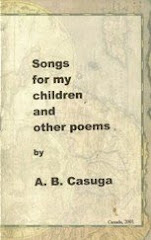 PART 6: CRITICIZING THE TECHNIQUE OF POETRY
PART 6: CRITICIZING THE TECHNIQUE OF POETRY--- THE ORDER OF STRUCTURAL PARTS
B. Order of Structural Parts. When a poem uses the dramatic incident context, the chronological order is normally utilized. Assertive context uses the logical order. When the context is an argument, either the logical order or psychological order is used depending on who is arguing and the state of his mind at the moment he makes the argument.
That order which brings about clarity, harmony, and integrity for the work should be the most effective.
The order in “Desert Places” (chronological, and also logical to a certain extent) serves the artistic purpose of objectifying the experience of a man who realizes his own emptiness because it starts from an awareness of external realities which become the stimuli for his realization. The cause of the realization properly precedes the effect which is asserted in the final stanza.
The poet who minds his technique is aware that the effectiveness of his poem depends largely on how he presents his images --- in an order which considers the workings and limitations of the mind and the processes of emotional reaction and motivation.
If T. S. Eliot proves difficult in his presentation of his selected objective correlatives, it is probably because the order he follows is beyond the real plane --- and that his metaphysical plane rarely takes as its springboard a definable reality limited by physical boundaries and constraints. The uncaring ellipses between his strofes do not make for a continuity that explains the interrelationship between and among allusions and assertions, dramatic incidents and assertions, and the like. Because they are unfamiliar, they baffle the reader into giving up on the poem.
In “The Love Song of J. Alfred Prufrock”, one is hardly able to follow the order even from the persona’s point of view. Even when it is viewed as a dramatic soliloquy, one would still be at a loss about the structural link of references to Michelangelo and the women vis-à-vis allusions to Prince Hamlet and Lazarus.
That is a clear order which finds its basis on some principle --- whether it is an order set by the consciousness of the poem’s persona, an order demanded by the intrinsic relationship between cause and effect, or from the seat of the unconscious which must, at any rate, find order in the choice of and connections articulated into various objective correlatives.
That order must first be understood in order to achieve a successful communication between poet and reader. It is, after all, a case of the appreciator knowing whereof to begin. It is only when he has started somewhere that the reader might permit himself to be “lost” in pleasant marvelling at the poem. Drifting with the images ends in further drifting – it is directionless – ultimately, fruitless.
Summarizing the elements of technique (which must be criticized alongside the poem’s style in order to render an evaluation on the work’s artistry), one may arrange these in the following organization:
TECHNIQUE
a. Presentation of Structural Parts. Central or Primary Structure, Secondary or Minor Structure, and Representational Structures
b. Scale of Poem. Stanza Forms, Lines, Words, Format
c. Order of Structural Parts. Chronological, Logical, Psychological, In Medias Res
AN INVITATION TO A PRACTICUM
Earlier analyses of “Desert Places” and “A Theory of Echoes” have provided enough empirical data on which criticism may now be based. The student, if asked to render a criticism of these two (Style and Technique), should therefore find it easy to judge the formal excellence of the poems. Testing himself, he should now try to criticize both poems for his personal satisfaction. The previous discussions provide the norms governing the critical process.
Since critical norms governing style and technique vary according to the peculiar emphases of artistic movements, it would be wise for the literary critic to acquaint himself with the characteristics of the major --- if not all --- artistic movements. These characteristics will more or less define the particular qualities peculiar to what is considered as “good art” or formally excellent objects of art in any given period of artistic development.
It is the student’s familiarity with the literary practices of these movements which would lead him to the formulation of his conclusions on the literary norms governing the literature of that time.
Next: Major Literary Movements Which Have Influenced Modern Literature: Realism, naturalism, Impressionism, Surrealism, and Stream-of-Consciousness











No comments:
Post a Comment